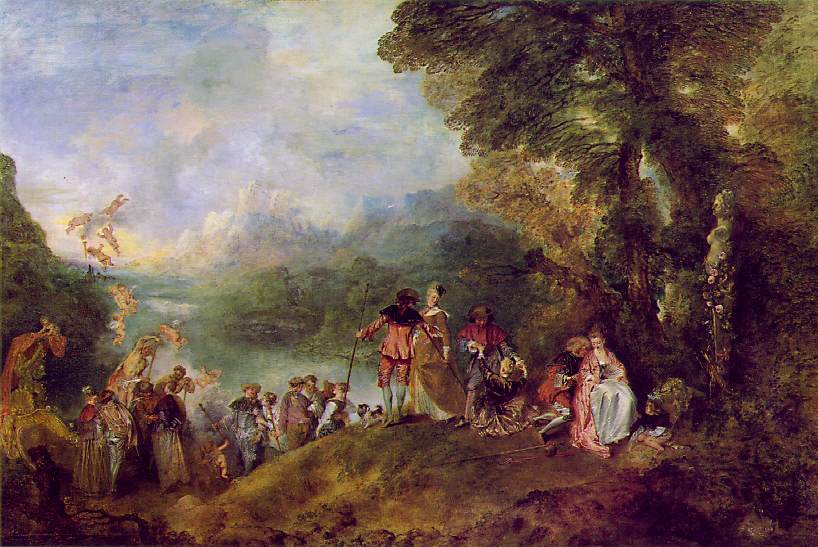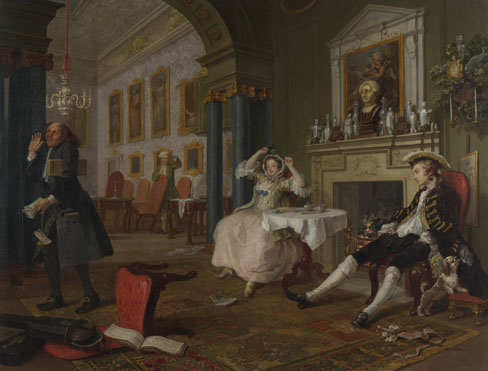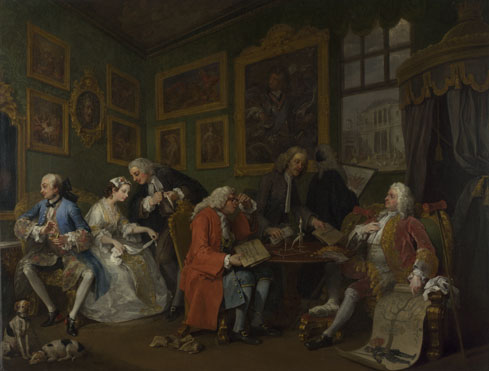Art has always been a medium for the reflection of the human condition. It shows us through varying degrees of distortion and a myriad of angles what life must have been like throughout time. As long as there has been a pictorial representation, there has been record of emotions, values, physical surroundings, ideals, tragedies, mischief and every emotion and circumstance known and unknown to human kind.
The visual art of the Classical Era, depicted a great shift in the established patterns that people had been accustomed to functioning with. We will see the opulence of the Rococo style which flourished in the beginning of the Classical Era, fade into the more sober and down to earth "swagger" style of the late classical period. Influenced by revolution, a shift in the societal status quo, the growing wealth of the middle class, and changing values of a new age of Enlightenment, the visual arts embark us upon a journey of discovery of the foundations for our modern age.
We begin with a piece which exemplifies the opulence of Rococo style and thus its implicit values of the period. Painted in Antoine Watteau's "L'Embarquement pour Cythère". we see the classical version of 'the good life'. Ladies and gentlemen confabulating, promenading, flirting, dallying and enjoying live music amongst joyful cavorting cherubs. Ah, those were the days! "Watteau’s distinct style forged the creation of an entirely new genre of paintings termed fête galante.
These works are admired for the subtlety of expression in the
characters’ faces and gestures, as well as the simultaneous inclusion of
both contemporary dress and costume attire, complicating notions of
time and place."(1)
 | |||||
| L'Embarquement pour Cythère C. 1717 Brussels, France |
This piece was submitted to the Royal Academy of Painting and Sculpture, but apparently Watteau was known to dally. "His friend, the Comte de Caylus, blamed him greatly for indolence and uncertainty. The delay was due in some measure to the frequency with which he altered the composition of his painting, going so far as to rub it entirely off on more than one occasion. Many times the authorities at the Academy made inquiries and addressed cautions. At last Watteau received a notice that the picture must be delivered within one month.With feverish haste this was accomplished, and the canvas was examined by the official inspectors." (2)
As the Classical Era progressed, the shift in emotions became apparent through the works of artists such as William Hogarth. His 6 piece series, "Marriage A la Mode" was meant as a poignant social commentary exposing the rich upper class for their corruption and declension. His paintings represent the opposite of what we saw from the Rococo style where everything was roses and rainbows so to speak. Hogarth was an English painter who was born in England on November 10th, 1697 and died on October 26th, 1764. He was the first great English-born artist to attract attention from abroad.
The first in the series "...shows the conclusion of negotiations between
the Earl of Squander (seated on the right) and the alderman (seated in
the centre) for the marriage of their children. The alderman, a rich
merchant, desires a higher social position for his family and thus is
buying his way into the aristocracy, while Squander needs money to fund
his overly extravagant lifestyle.
Meanwhile, their children are displaying either supreme
indifference or misery at the proceedings. The son, Viscount
Squanderfield is dressed in the latest Paris fashions, after his recent
return from the continent. The black spot on his neck indicates that he
has syphilis. The alderman’s daughter is inconsolable, but is being
comforted by the lawyer Silvertongue. The fact that the couple will be
bound together in an ill-matched, loveless marriage is made clear by the
chained dogs."(3)
 | |
| William Hogarth's Marriage A la Mode 2 C.1743-45 |
 |
| William Hogarth's Marriage A la Mode 4 C.1743-45 |
From these select pieces we can see that Hogarth was determined to bring to light the reality of the life of the affluent of his time. I personally enjoy the second picture, with the viscount slumped into a drunken state on the chair on the right, and his wife stretching next to him, presumably after quite a night herself- perhaps some amorous dalliance on the side all too quickly interrupted by her husband.
Unfortunately for Hogarth, his social commentaries on canvas were ill received, and he did not prosper financially from them. He was best known for his satirical moralities, and his engraving- which he did in an unusual manner. He would actually paint his work in reverse so that the engraver (often himself) could carve it straight on rather than looking into a mirror to copy it.
During the later part of the Classical Era, Neoclassicism came into vogue. Its bold colors, unfrilly subject matter and references to ancient (then classical) times gained quickly in popularity. Some key characteristics of the style include references to Ancient Roman and or Greek architecture or subject material, exquisite attention to detail and realistic representation as well as creating a completely polished appearance without visible brush strokes.
"Neoclassicism in painting gained a new sense of direction with the sensational success of Jaques Louis David's Oath of the Horatii at the Paris Salon of 1785.
Despite its evocation of republican virtues, this was a commission by
the royal government, which David insisted on painting in Rome. David
managed to combine an idealist style with drama and forcefulness..."(4)
 |
| Jaques Louis David's "The Oath of Horatii" C.1784 Rome |
What particularly appeals to
me about this painting is the stark use of contrast in the light and
dark. It gives it a tangible drama that draws you into the moment's
intensity. I marvel at the detail present even on the legs of the
soldiers, the way their veins bulge reminds me of watching people work
out at the gym. This piece represents the fierce and heroic morals of the ancient times where brave warriors sacrificed themselves for their people. For a full description of this painting's subject material, please visit: http://en.wikipedia.org/wiki/Oath_of_the_Horatii
As we have seen, the Classical Era witnessed a robust change in
techniques, themes, representations, and morals. Big worldly changes
bore huge changes in art and the way artist portrayed the world.
(1) "Jean-Antoine Watteau | L'Embarquement Pour Cythère (The Embarkation for Cythera) (1717) | Artsy." Jean-Antoine Watteau | L'Embarquement Pour Cythère (The Embarkation for Cythera) (1717) | Artsy. Web. 19 Oct. 2014.
(2) "Full Text of "Watteau and His School"" Full Text of "Watteau and His School" Web. 19 Oct. 2014.
(3) "Hogarth: Hogarth's Modern Moral Series, Marriage A-la Mode." Tate. Web. 19 Oct. 2014.
(4) "Neoclassicism." Wikipedia. Wikimedia Foundation, 16 Oct. 2014. Web. 17 Oct. 2014.

I really enjoyed your blog it is very thorough and well written. I was not overly impressed with the paintings by Hogarth when I first looked at them; the colors were dull and dreary. The narrative of your interpretations, symbolism, and their relationship to morality piqued my interest, and made me want to find out more about them. Upon closer inspection of the series of paintings there is a lot of “scandalous” things going on in most of them. I found that “the Bagnio” (http://upload.wikimedia.org/wikipedia/commons/1/10/William_Hogarth_039.jpg) was the most scandalous of them all, what do you think?
ReplyDeleteI loved reading your blog post, it was amusing and really well done! It was really cool to read about all the little details in Hogarth's paintings, and about Watteau's inclination to procrastination. After studying Hogarth's paintings a bit more, it would seem that he saddles the line of Rococo and Neoclassicism, the people showing the lavish lifestyle of the Rococo mixed with the color palette of Neoclassicism. You made reading about the shift from Rococo to Neoclassicism a good one!
ReplyDelete